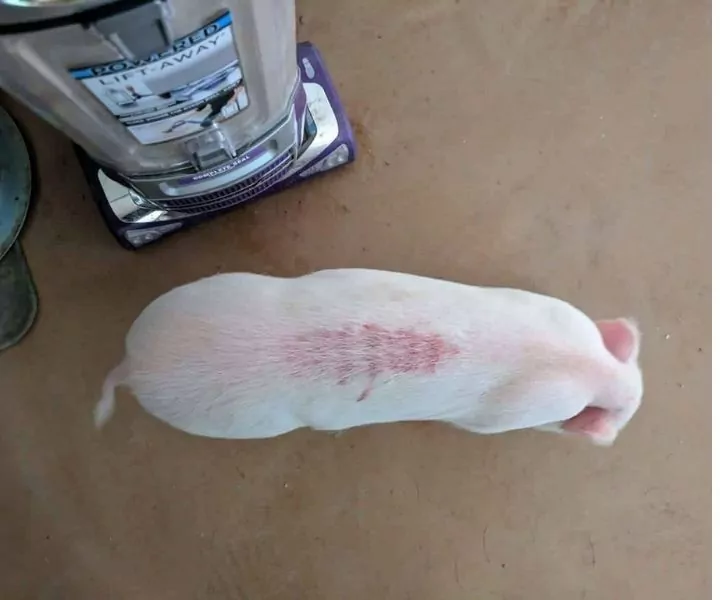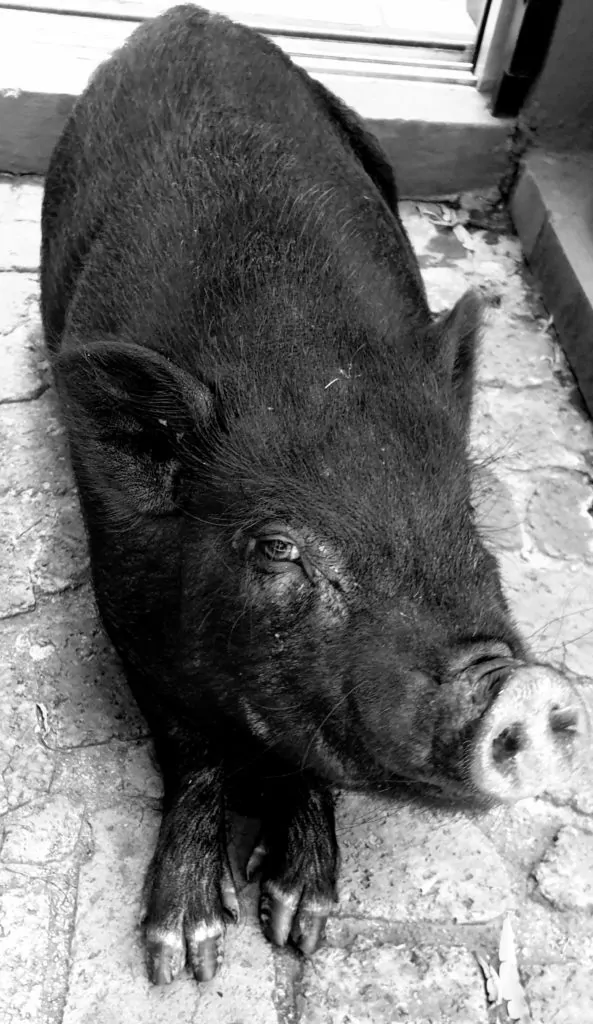What is Wrong With my Pig?
Such a weird name for a condition that unfortunately has no cure up to now. Dippity Pig Syndrome or Erythema Multiforme is also sometimes referred to as Bleeding Back Syndrome. It is extremely painful and is categorized as a skin condition that commonly occurs along the lower spine of young piglets.

It is extremely traumatic for pet owners, commercial pig farmers, and the swine themselves as well. This is a relatively new concept in the medical world. Therefore it is not yet known if a pig’s hind legs drop as a result of pain, or whether the spinal cord is immobilized for a certain period of time and as a result, make them lose control during the onset of Bleeding Back Syndrome.
Clinical Signs, Symptoms, and Facts on Dippity Pig Syndrome
Clinical signs and symptoms associated with bleeding back syndrome, are not limited, but includes:
- Occurring in pigs between the ages of 4 months and 4 years.
- It happens suddenly, without warning, and can be fleeting or range over the course of a few days.
- Pigs will squeal or scream in high-pitched tones, due to the amount of pain it causes.
- It is categorized by a range of whip-like lesions across the back of the pig and will bleed spontaneously – almost as if they’ve been beaten by a whip or it will look like grill marks from a barbeque.
- Temporary loss of hind legs. Your pig may drag their hind legs on the floor behind them. However, their front legs will remain unaffected.
- Oozing of pus or blood from the wounds that will run across the back horizontally, instead of vertically.
- Pigs will try to run away from the pain and might diss owners or display aggression as they obviously don’t understand that you were not the cause of the pain.
- Your pig will still eat and drink as normal, albeit in a lying-down position.
- The swine’s urination and feces will appear normal.
- The pig’s body temperature will be normal.
- The symptoms can last between two to four days.
- It is common for Dippity Pig Syndrome to reoccur many times over the minipig’s life span.
- The condition is also common in show pigs, pet pigs and is not so prevalent at pig farms.
- The biggest contributing factor to this mysterious condition appears to be stress.
- Your pig’s back, especially the hindquarters are sensitive to touch. Even for a few days after, scabs will start to form – you should not touch these or pick them, it will fall off by themselves.
The Causes of Erythema Multiforme
Erythema Multiforme is idiopathic. Meaning there are no known causes for the condition. However, some studies have suggested that Dippity Pig Syndrome is similar to the herpes virus in humans. Other evidence has also suggested that this condition is hereditary in certain breeds.
However, any pig breed or age is susceptible to this behavior, even though none are predisposed as such.
What Should I do if my Pig Has Dippity Pig Syndrome?
There are a few ways in which you can help ease the burden of this debilitating condition in minipigs and other swine counterparts. It is especially traumatic for me as a mini pig owner to have to through this and see my pet in pain, but it is manageable.
I employ the following tactics:
- The minipig is lured into a quiet room, with the curtains drawn – much like when humans have a migraine.
- There is either complete silence, or soft music played in the background.
- Administer a dose of medication (see paragraphs below) and mix this with a little bit of yogurt.
- Exercise patience and strive to talk in a soft and calm voice, giving treats and soft pets and cuddles if the animal allows it.
- If the pet permits, lie down next to them and take a nap or just cuddle them and keep them calm at all times.
- Reduce any factors that can cause additional stress to your pig and remove these factors from the situation or remove the pig from it.
- Allow the pig some time to rest by isolating it from other people and other animals in the household, until they are ready to come out.
- Keep your pig as still as possible.
- Make use of puppy training pads or a pee mat if they tend to go potty outdoors.
At-Home Remedies For Dippity Pig Syndrome
In addition to the above-mentioned, you can also administer a dosage of medication that targets pain and one that will induce sleep in your pet to allow them to rest properly. Of course, as fellow mini pig owners, we know that they are forever toddlers and can just be as stubborn as one too! LOL!

For Pain
- You can try buffered aspirin at 5mg every 12 hours. DO NOT administer for more than three days.
- Or, you can try to administer Tylenol or Nurofen for Kids also at 5mg, but only every eight hours. Tylenol for infants can also be used at 1cc per six pounds.
- You can also contact a Vet and ask them to prescribe Tramadol or Buprenex for pain management.
It is crucial that you give any medication with a treat or a meal! And like humans – never on an empty stomach, unless otherwise indicated by a veterinary professional.
For Resting
- Administer diphendrymine such as Benadryl at 1mg every eight hours.
When to call The Vet for Erythema Multiforme
When nothing that you’ve tried appears to help – it’s time to call your local specialized veterinary practitioner. Some other reasons to call them up, include:
- When you are worried about your pig. No vet worth their salt will think less of you if you are concerned about the welfare of your pet.
- Your pig is not responding to at-home treatments.
- If Dippity Pig continues for more than four days consecutively.
- When both the front and the hind legs are compromised – then it’s not Erythema Multiforme or Bleeding Back Syndrome.
- If your pig is not eating or drinking as normal.
- When your pig is continuously in pain – trust me, they will let it be known and in an awful manner at that!
- If your pig runs a fever.
- When your pig is not responsive.
Ways to Prevent Dippity Pig
The good news is that this disease is definitely treatable and in most cases it is self-limiting. Unfortunately, it is categorized as a virus and is, therefore, best left to run its course, even though this might sound harsh!
Currently, there is no vaccine for this condition, because it is so new. But hopefully, as more research is conducted, there will be medical advancements in this field very soon. What I can tell you from personal experience is to either remove stress factors away from your pig as much as possible or to get them used to change and these stressful environments to allow them to develop coping strategies.
One instance that I distinctly recall, is Scout being three months old when Dippity Pig Syndrome struck first. I was overcome with anxiety, which I am sure she felt too due to their high intelligence!

It did not take me long to determine that Scout has Bleeding Back Syndrome. But after it all subsided, I was determined to enquire why it happened and how I can prevent it. For the life of me, I wasn’t able to pinpoint the exact cause, but I am sure it is a result of having people sleep over, which happened for the first time since we got her.
It might not work for everybody, but I got her used to having other people around, and since then, it has only happened to her about three or four times afterward, and she is a hit amongst any visitors we now have, with no signs of Dippity Pig Syndrome.
Any pig owner will tell you that pigs don’t like change. This spreads across the board to strangers at your house, changes in diet, changes in their environment, or even your routine as their caregiver. They are creatures of habit and detests when the plan does not work like clockwork.
What to Expect Afterward
Within a few days, or even hours if you are lucky, your pet pig and their behavior will be back to normal, barring the scabs of the lesions forming and eventually falling off in their own time. When your pig is not sensitive to the touch on these now crusty lesions, you can try to apply some coconut oil.
They might not be keen to come close to you or allow you to touch them for a few days, but with patience, love, and care – your bond will be back to normal in no time.
For your pig, it will be like it had a nightmare and nothing else!
